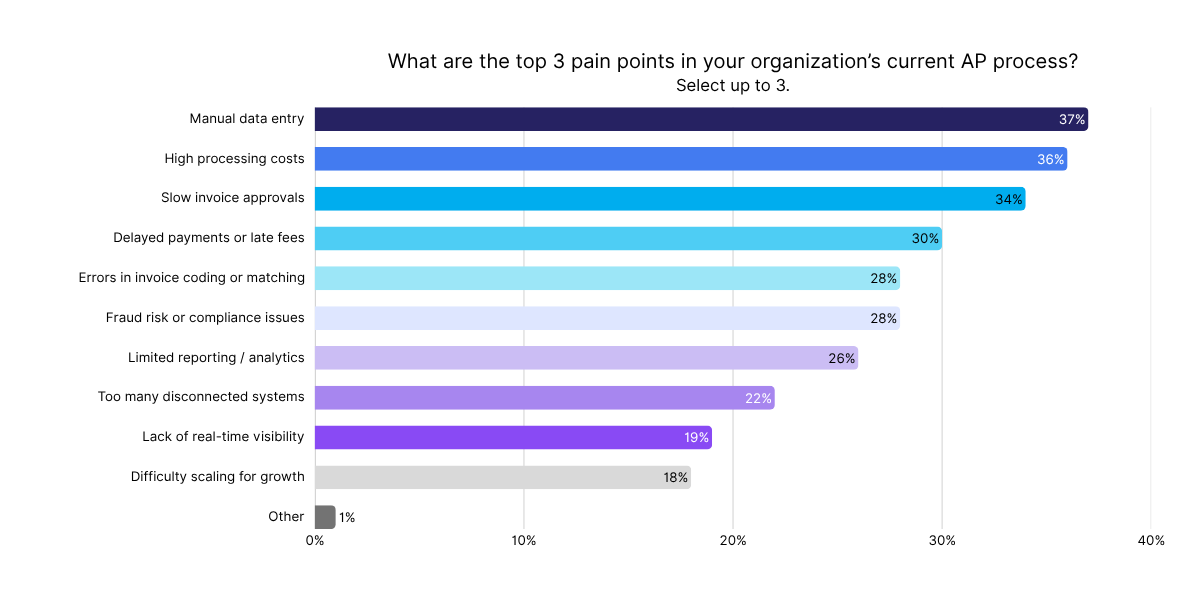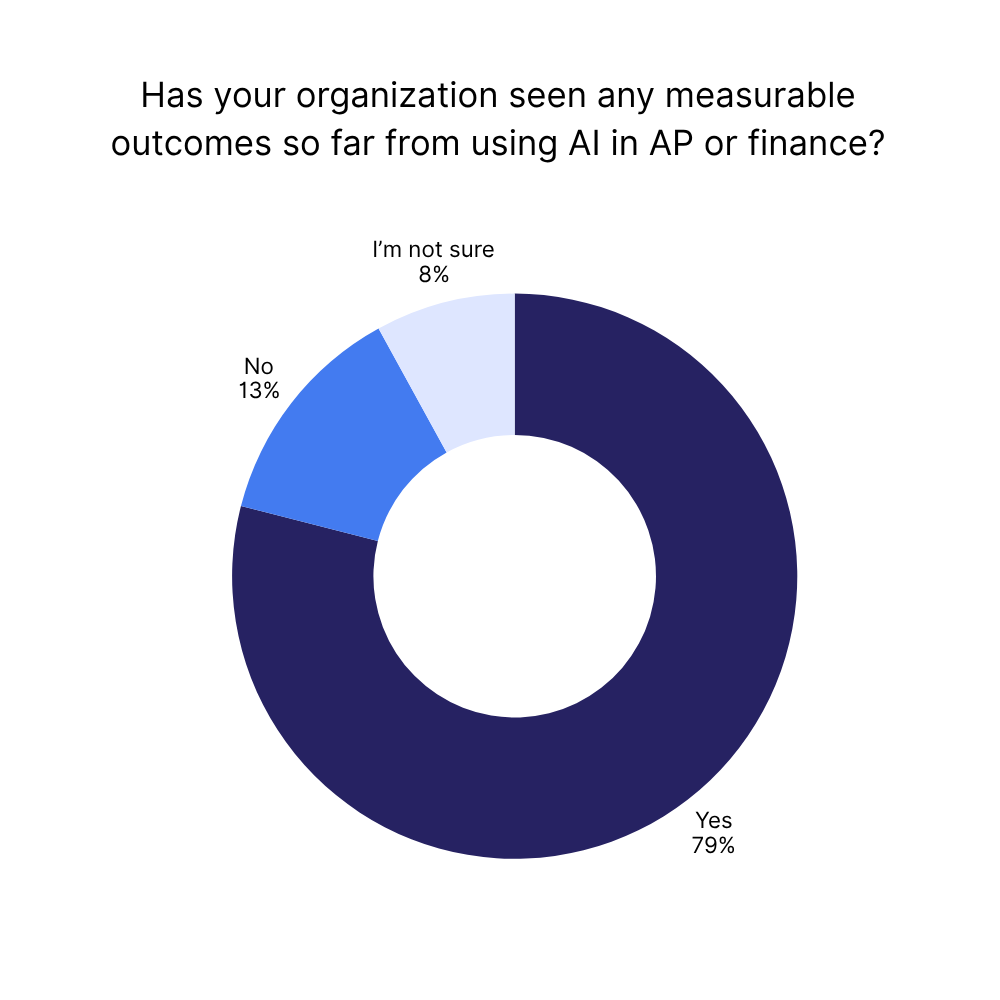For all the talk of automation, there’s one task finance teams can’t seem to shake: manual data entry. In practice, that means keying invoice numbers into ERP systems, retyping vendor names and totals from PDFs, cross-referencing purchase orders against receipts, and double-checking line items for accuracy — often across multiple platforms that don’t fully talk to each other.
According to the new AI Momentum Report, 37% of accounts payable (AP) professionals still cite manual data entry as their top pain point — more than any other issue.
Even in 2025, with AI mainstream and ERP systems nearly universal, this most basic bottleneck still defines the daily grind for many AP teams. It’s a reminder that despite impressive progress, true automation maturity is still uneven — and that humans are still spending far too much time on work machines should handle.
The everyday reality of AP workflows
Across industries, AP teams sit at the intersection of process, pressure, and precision. They manage thousands of invoices every month, balance compliance demands, and keep vendors paid on time. The reality, however, is that ERP integration hasn’t eliminated manual work — it’s just changed where it happens.
While 91% of organizations report some level of ERP sync with an automation tool, partial integrations remain the norm. That means teams are still spending valuable time rekeying data, reconciling mismatched entries, and validating details across multiple systems that don’t fully communicate. The top pain points tell the story clearly — and they’re all connected:
- Manual data entry (37%) – Teams are still typing invoice numbers, dates, and totals into ERP systems by hand, often duplicating information that already exists elsewhere. It’s slow, tedious, and inherently prone to errors.
- High processing costs (36%) – Every manual touchpoint adds labor hours. Between intake, validation, and approvals, these small inefficiencies stack up into some of the highest costs per invoice across the back office.
- Slow approvals (34%) – Routing invoices through multiple systems and approvers delays payments. Even with workflow tools, human checkpoints create friction that compounds across hundreds of invoices a day.
- Delayed payments or late fees (30%) – When processes stall, vendors wait — leading to missed discounts, strained relationships, and cash flow uncertainty. These downstream effects are often the most visible symptom of upstream manual work.
- Coding errors, fraud risk, and compliance gaps (≈28%) – Inconsistent data entry and fragmented workflows increase the risk of misclassified expenses, duplicate payments, and audit findings — turning small mistakes into big liabilities.

Together, these pain points show a clear pattern: automation exists, but fragmentation persists. Even organizations that consider themselves “automated” are still heavily dependent on people to fill in the gapst. The result is an expensive cycle of manual oversight that undermines both efficiency and accuracy, proving that the last mile of AP automation is often still walked by hand.
Why data entry is the wrong job for humans
Manual data entry doesn’t just slow things down — it wears teams down. As finance organizations grapple with talent shortages and rising workloads, AP managers say the hardest roles to fill are those tied to repetitive processes. And once hired, employees spend too much time copying information from invoices instead of analyzing spend or supporting audits.
It’s tedious work with little upside. Every keystroke is a chance for error, and every hour spent retyping invoice data is an hour not spent on strategic tasks.
Respondents to the survey put it plainly:
“AI handles data entry and invoice matching, freeing team members to focus on higher-value work.”
“Routine tasks like invoice data entry are now automated — accuracy is higher and morale is better.”
“AI-powered systems now automatically extract invoice data, match POs, and route approvals based on learned patterns.”
“It’s made everyone’s jobs easier and the process faster — we no longer have to work late or on weekends.”
The message across respondents was consistent: when you take the monotonous and repetitive work off people’s plates, everything improves — speed, accuracy, and engagement. These aren’t just nice-to-have improvements; they’re critical for retaining skilled finance talent. When employees see their impact shift from data entry to decision-making, job satisfaction rises — and so does accuracy. And, the market is seeing this shift with the adoption of more advanced technology, such as AI-powered solutions.
Persistent pain, partial progress
The research shows that most organizations have tried to fix these issues — 69% have attempted to build AP automation internally. Yet many of those efforts stall due to integration hurdles, compliance concerns, or limited resources. The result is a patchwork of tools: OCR systems, workflow apps, and RPA scripts layered on top of spreadsheets.
This fragmented approach explains why 44% of organizations still use some form of manual entry alongside their automation stack. The gap between automated in theory and automated in practice remains wide.
The new approach: Intelligent, not just automated
Traditional automation has always had limits — rules-based workflows still require manual review and upkeep. What’s changing now is the arrival of AI-powered systems that learn from data and context instead of relying on static rules.
AI tools can recognize invoice formats, extract key fields accurately, and even detect anomalies automatically — without needing to be told what to look for. It’s why 45% of organizations now use AI in finance or AP, and why data extraction (46%) ranks among the most common use cases.
Importantly, AI isn’t replacing people — it’s amplifying them. A full 64% of finance leaders view AI as a productivity enhancer or digital assistant, not a job threat. Teams remain in control, but their time is finally being spent on review, analysis, and exception handling instead of repetitive entry.

When you get it right: Measurable outcomes
Organizations that have embraced AI in AP are seeing real, measurable results. Among those using AI:
- 79% report tangible benefits
- 50% see faster invoice processing
- 46% see faster approvals
- 44% report improved employee satisfaction
- 42% experience stronger payment timing and discount capture
These outcomes highlight a dual payoff: operational efficiency and human benefit. Processes move faster, errors shrink, and employees feel more empowered. AI doesn’t just speed things up — it changes the quality of work itself.
The reality check — and the opportunity ahead

It’s tempting to assume AP’s biggest challenges were solved years ago. But the data tells a more grounded story: automation has come a long way, yet manual work still defines the experience for many finance teams.
Even among organizations using modern workflow tools or ERP integrations, human intervention remains. The good news is that the same technologies transforming other parts of the business are finally reaching AP in a practical, measurable way. The focus is shifting from removing people to elevating them — turning AP professionals into stewards of accuracy, insight, and compliance rather than gatekeepers of data entry.
That shift is already visible in how finance teams describe their work:
“AI tools reduced manual tasks and improved accuracy in our finance workflow. The team now spends time on analysis instead of entry.”
“With AI handling routine tasks, our AP staff focus on exceptions, data analysis, and supplier strategy — not typing.”
“Less manual work, more focus on analytics and vendor relationships.”
“It’s lightened the load and allowed us to focus on other priorities. Everybody is happier with the technology upgrades.”
These comments point to a broader transformation — one built on trust, transparency, and time saved.
For AP leaders, the opportunity now isn’t just to automate faster, but to automate smarter — connecting systems, closing the last manual gaps, and proving value in accuracy, insight, and employee experience.
That’s the vision worth scaling: not automation for its own sake, but automation that delivers real, measurable value for both people and performance.
Access the complete AI Momentum Report for these survey findings and other key insights.











.svg)
